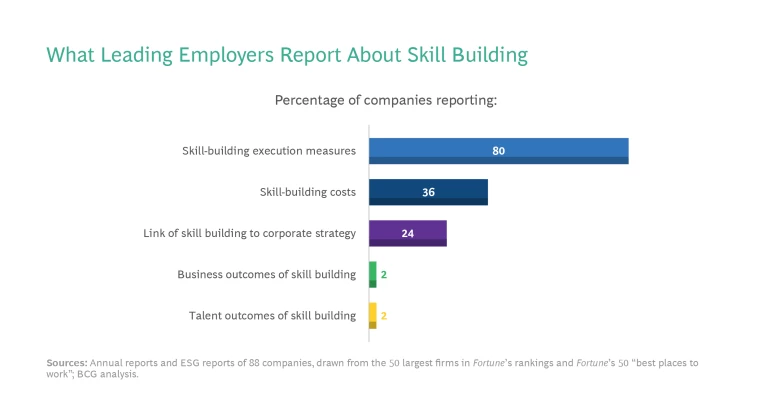Corporate leaders frequently proclaim, “Our people are our greatest asset.” But when it comes to ensuring that this asset is fully prepared and capable, it’s clear that improving workers’ skills isn’t a top priority.
Even though leading companies spend up to 1.5% of their annual budgets on learning and skill building—comparable to what many firms spend on transformation programs or IT—their leaders do not discuss skill building in the same way they do other goals. Our research shows that few companies tie skill building to strategy or report on how they manage skills in the same way they do for other important assets.
This lack of prioritization threatens to become an existential problem at both the individual-company and macroeconomic level. The World Economic Forum has estimated that 50% of the global population needs new skills to meet shifts in demand driven by new technologies. By 2030, this figure may grow to as high as 90%. Failing to meet the demand for new skills could cost as much as $15 trillion in lost GDP. Governments have a huge role to play in closing the projected gaps, but business has an essential job to do as well—and it is in companies’ self-interest to step up.
The State of Skill Building Today
To assess the state of skill building, we examined the annual reports and environmental, social, and governance (ESG) reports of 88 leading firms chosen from Fortune’s rankings of the 50 largest US firms and the 50 “best places to work.” We analyzed how these firms describe their skill-building efforts and the KPIs they report. We combined this data with our own experience working closely with C-level leaders around the world on learning and skill building . Our findings suggest that companies need to devote far more attention to fostering skill building, tracking its outcomes, and elevating its role and profile in the organization. (See the exhibit.)

Skill building is not on top of mind. Of the company reports we analyzed, 20% do not include any mention of learning or skill building, and in many others, the topic is only touched on in a generic paragraph on HR or social responsibility. The consideration paid to skills today compares with the attention given to diversity, equity, and inclusion (DEI) about 15 years ago. Now, it’s not uncommon for a company to devote three to five pages to DEI, including details on measurement and commitments, and individual employee stories.
Many firms aren’t devoting enough attention to skills—even though this is in their best interests.
In our experience, senior leaders do not put much internal emphasis on skill building either. In a 2020 BCG study of the learning capabilities of 120 large global companies, only 15% said they granted corporate learning the high priority it deserves.
Skills are not linked to corporate strategy. The same BCG study shows that less than 15% of leaders believe that learning constitutes a core part of their company’s overall business strategy . For most organizations today, skill building is viewed as an HR initiative instead of being tightly integrated with corporate strategy . Only 24% of corporate reports put skill-building efforts in the context of corporate strategy, and those that do describe these efforts in simple, qualitative ways, typically discussing strategic priorities and referencing skill building in this context. Only a handful of companies indicate that they have a structured process for forecasting skill gaps based on corporate business needs.
Companies’ reporting on skill-building outcomes is limited. Companies talk about the process they follow to build workers’ skills, but few disclose the results they achieve. Four out of five of companies report on process metrics related to training, such as hours of training delivered or number of people who attended courses. But these numbers tell us very little about what was actually achieved. Here’s a typical (sanitized) example from our research: “In 2021, we rolled out 56 new programs. … [We] issued more than 24,800 certifications and provided almost 350,000 hours of training.” Meanwhile, only 4% of companies report on the outcomes of their skill-building programs in terms of business outcomes (such as improved productivity or application of a new tool at work) or talent outcomes (such as higher employee engagement or the employability of participants).
Skill building is typically described as an expense. Despite the clear importance of skill building and the significant budgets devoted to it, most leaders view it simply as an expense, not unlike equipment maintenance. Only 36% of companies report on the financial resources they dedicate to skill building, and those that do mostly position it as a cost and rarely as an investment, or more specifically, an investment in future capabilities. The spending is significant: companies in our analysis allocated between 0.5% and 1.5% of their annual budget to skill building, an average of $150 million per year and often much more. Learning and development budgets of $300 million or even $400 million are not uncommon. But as long as these budgets are considered costs, this spending is likely to have a lower priority than other investments. As the chief human resources officer of a global industrial goods firm told us, “When there is a pressure on costs, the first thing to be cut is the learning and development budget. How do we expect the business to sustain results when the core resources—that is, the people—don’t have the capabilities to deliver?”
Upgrading Skill Building
Companies need to step up their efforts in skill building, which starts with reframing it as a strategic priority. As the former chief human resources officer of a large automotive company put it, “Investors, regulators, and employees are interested in what a company does to future-proof the skills of the workforce. Since COVID, people topics are taken much more seriously, and it is only a matter of time until the skills topic is elevated to the strategic importance that it deserves.”
Our research and client experience suggest five practical strategies to elevate the importance of skill building in the organization.
Start with strong strategic intent. All companies need a plan to develop the skills required to deliver on their business strategy. They should also take steps to reassure investors and other stakeholders that they have such a plan. This doesn’t need to take the form of a complicated workforce plan; it can start with a sharp articulation from the C-suite of how skill-building efforts tie to key strategic business priorities. For example, the German insurer Allianz states in its 2021 sustainability report that “Digitalization and automation will change the composition of the future workforce with some job profiles no longer existing, new profiles and capabilities emerging, and considerable changes in existing profiles and skills. This will require major upskilling and reskilling initiatives to prepare the workforce for the future. Our main focus will be on developing digital, data and agile working skills. Skills like IT security , communications and HR will also be essential.” Allianz also reports what this ambition means in quantitative terms: “3,155 FTEs recruited and reskilled in strategically relevant talent segments in Allianz operating entities in 2021 (2021 plan: 2,177).”
Account for the will behind skill. Companies should position skill building as they do other investments. The World Economic Forum recommends “treating investment in human capital in the same way we do investment in natural resources, particularly oil. … [T]he investment in the workforce could be capitalized and recognized on the balance sheet.” As our analysis shows, this is not a common practice today. Reclassifying balance-sheet categories may be difficult, but employers can clearly dedicate a budget to strategic skill building and measure how it is spent. Doing so will send a strong signal to the workforce that the company is invested in them. For example, Bosch has announced it will spend €2 billion on reskilling workers as the auto industry shifts to electric vehicles. Amazon plans to spend $1.2 billion to give 300,000 employees access to education and training programs.
Focus on outcomes over process. Public disclosure can be a powerful motivator, but only if the focus is on the right metrics. By shifting the reported results from “number of employees trained” to “business and talent outcomes achieved,” companies can drive higher-order impact and keep the organization focused on skill-building investments. Business outcomes can be measured on multiple levels, such as looking at the application of learning at work (Did workers use the new technology? Did they exhibit new competencies?) or by looking at metrics of achievement (faster or cheaper production or greater sales). The assessment of outcomes should also focus on how learning improves the skills, capabilities, engagement, and employability of participants.
For the most impact, businesses should report on the results of skill building, not on process.
Take the example of AT&T, whose March 2022 ESG Summary reports on the impact of the company’s new Real Time Training program: “We identify who needs training and when, as well as which training solution is most likely to drive the greatest performance improvement for an employee’s respective KPIs. In 2021, approximately 1,950 employees received real time tutorial recommendations, resulting in [about] 4.3K incremental new customers [and about] $4.5M in incremental annual revenue.”
In addition to tracking business results, AT&T also monitors the impact of training on participating talent. According to the company’s March 2022 ESG Summary, “Our metrics show that those who take part in our training and development initiatives are:
- more likely to receive a higher performance rating at the end of the year
- more likely to receive a higher key contributor award at the end of the year
- more likely to move laterally
- less likely to leave the company”
Many companies shy away from trying to quantify outcomes because the exercise can be difficult, but as the experience of one large North American retailer shows, it does not have to be a complex problem-solving exercise. The company ran a pilot using a test and a control group to demonstrate a clear business case for its frontline leadership-development program before scaling the program across the organization. The pilot showed a sales increase of 150 basis points for the test-group stores over the control group. Other companies use existing or easy-to-capture data, such as information from learning-management systems or self-reported training results. When no data is available on outcomes, companies can at least tell success stories or showcase case studies on the impact of skill building.
Subscribe to our People Strategy E-Alert.
Inspire commitment, not compliance. Measurement is critical, but numbers alone won’t drive new behaviors. Senior business leaders, not just HR, need to highlight the importance and urgency of skill development for every individual—including themselves. Leaders can encourage buy-in with stories of their own skill-building journeys. For example, one professional-services firm began implementing its strategic “upskilling” program by asking senior leaders to participate in training programs and then share their experience with their teams. Corporate communications vehicles can showcase examples of “skills heroes” who make successful career pivots or create real business value by building new skills in such areas as data analytics or agile ways of working .
Put skill building on the everyday agenda. Leaders don’t need to wait for investor days or quarterly strategy reviews to emphasize the importance of skill building. They can instill a life-long learning culture in their organizations through simple, regular reinforcements. For example, they can make it a practice to ask, “What would we like to learn as a team and individually?” at the beginning of new assignments and encourage team members to identify new skills acquired during weekly team meetings.
Companies can count on two developments: the importance of a skilled and capable workforce will only increase, and the half-life of critical skills, particularly those related to advanced technology, will continue to shorten. The successful companies of the future will not only invest in human capital but also put the same level of effort and attention into tracking and reporting on skill building that they devote to investing in financial or tangible assets.
The authors wish to thank Laura W. Geller, Executive Editor at the BCG Henderson Institute.










